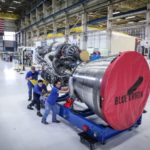The Rolls-Royce Trent 7000, the latest member of the Trent family of engines, has successfully powered the new Airbus A330neo into the skies for its first test flight today.
The aircraft took off from the Airbus facility in Toulouse, France, this morning, marking the beginning of a flight test programme.
The Trent 7000, the exclusive engine for the A330neo and the seventh in the Trent series, brings together:
- Experience from the Trent 700 – the engine for the current A330
- Architecture from the Trent 1000 TEN – the latest version of the Trent 1000 engine
- Latest technology from the Trent XWB – the world’s most efficient large civil engine
According to Rolls-Royce, the 68-72,000lb thrust Trent 7000 delivers a “step change” in performance and economics compared to the Trent 700 engine, improving fuel consumption by 10% and offering twice the bypass ratio.
The flight also marks an important milestone for Rolls-Royce as it celebrates its third ‘first flight’ in less than 12 months, the others being the Trent XWB-97 and Trent 1000 TEN. The company called it “an unprecedented achievement in the aerospace industry”.
Before today’s first flight, the Trent 7000 has undergone a series of ground tests, including: altitude, icing, cross-wind, noise and cyclic testing in USA, and endurance, operability and functional performance testing in the UK.
Eric Schulz, Rolls-Royce, President – Civil Aerospace, said: “This is a great moment for Airbus and Rolls-Royce and I am proud to see the latest member of the Trent family power this outstanding aircraft for the first time today. We have helped Airbus create a new product that offers customers a transformation in performance and economics. We are now focused on supporting the flight test programme and ensuring our customers have a smooth entry into service.”
The Trent 7000 will power the entry into service of the A330neo next year with Portuguese operator TAP.
Trent 7000 by numbers
- The front fan is just under 10 feet across and sucks in up to 1.3 tonnes of air every second at take-off.
- High pressure turbine blades inside the engine rotate at 12,500 rpm, with their tips reaching 1,200mph – nearly twice the speed of sound.
- At take off each of the engine’s high pressure turbine blades generates around 800 horsepower per blade – similar to a Formula One racing car.
- At full power, air leaves the nozzle at the back of the engine travelling at almost 1000mph.

